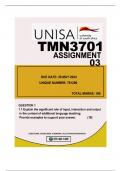, TMN3701 ASSIGNMENT 03 2024
DUE DATE: 28 MAY 2024
Unique Number: 781296
QUESTION 1
1.1 Explain the significant role of input, interaction and output in the context of
additional language teaching. Provide examples to support your answer. (10)
The role of input, interaction, and output in the context of additional language teaching is crucial in
facilitating the language acquisition process. These three components work together to help learners
develop their language skills in a natural and immersive way.
Input refers to the language that learners are exposed to, whether it be written or spoken. It serves
as the foundation for language acquisition, as learners need exposure to comprehensible input in
order to internalize the structures and patterns of the language. This can come in the form of
listening to a teacher speak, reading a book, or watching a movie in the target language. For
example, in a Spanish language class, students may listen to a recording of a native Spanish speaker
conversing in a casual setting. By hearing and consuming this input, students can begin to
understand the flow and nuances of the language.
Interaction plays a pivotal role in the language learning process, as it allows learners to actively
engage with the language and receive feedback from others. This can occur in a variety of settings,
such as classroom discussions, group activities, or one-on-one conversations with a teacher or peer.
Through interaction, learners have the opportunity to practice speaking and using the language in
real-time, as well as receive immediate correction and guidance. For instance, in a French language
class, students may participate in pair or group activities where they must engage in conversation
and work together to solve a problem. This type of interaction not only encourages speaking and
listening skills, but also fosters collaboration and teamwork.
Output, the final component, refers to the language that learners produce themselves. This can take
the form of speaking or writing, and serves as a way for learners to demonstrate their understanding
of the language and apply their knowledge in a meaningful way. By producing output, learners are
able to practice their language skills and receive feedback on their performance. In a Japanese
language class, for example, students may be tasked with writing a short essay in Japanese about
their daily routine. This not only allows students to practice their writing skills, but also provides an
opportunity for the teacher to assess their comprehension and offer constructive feedback.
The significance of input, interaction, and output in language teaching cannot be understated. The
input provides learners with the necessary exposure to the language, the interaction allows for
active engagement and feedback, and the output allows for the application and demonstration of




